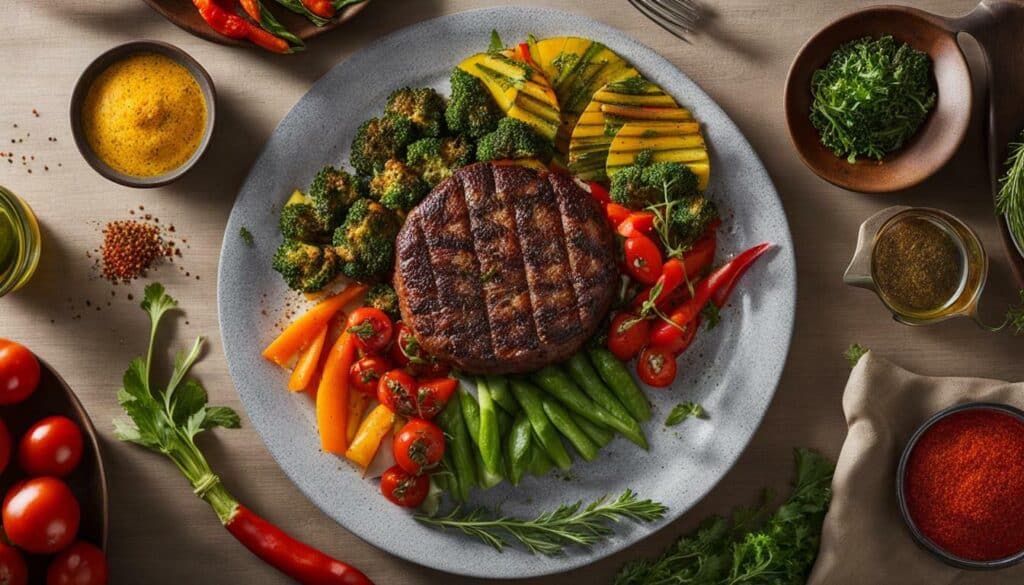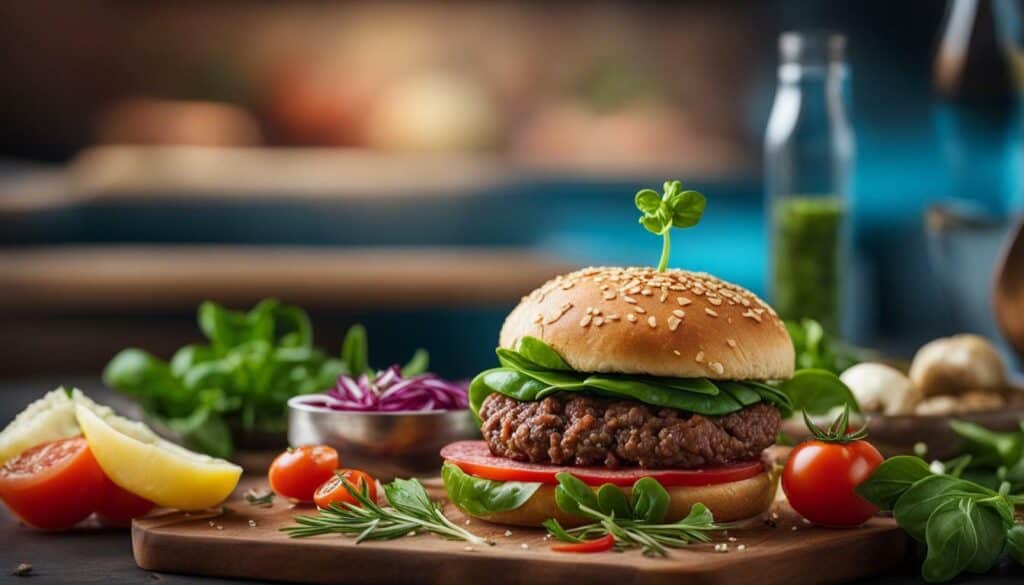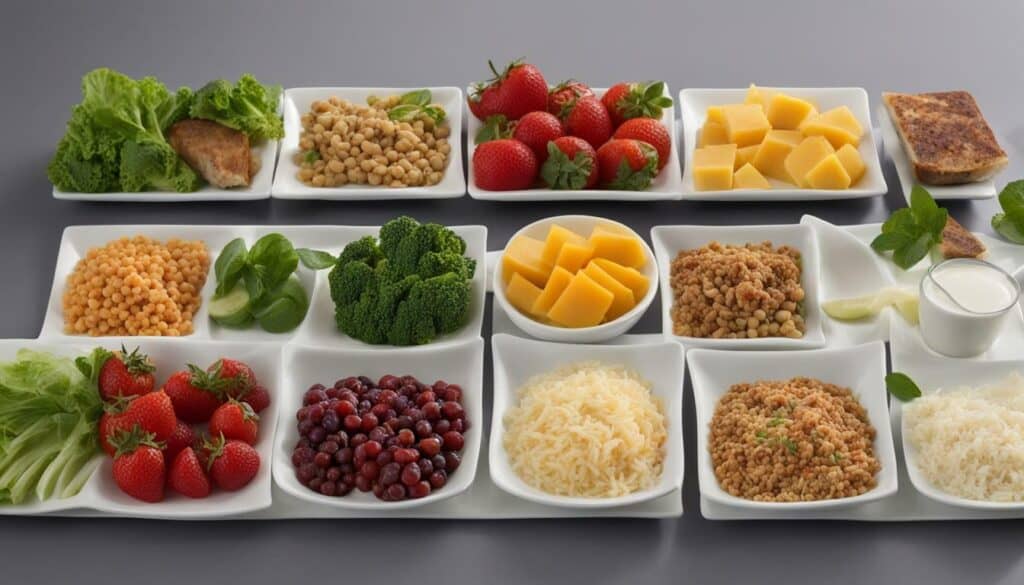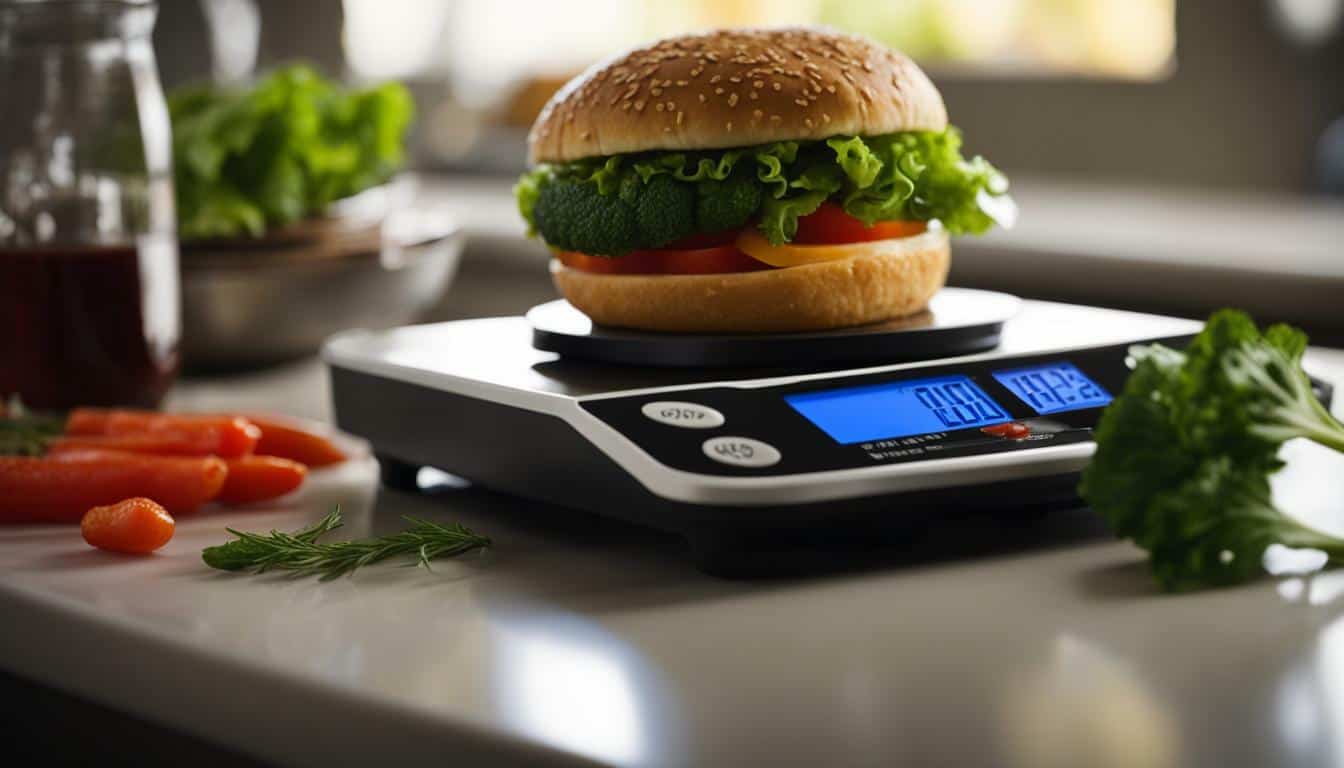When it comes to maintaining a healthy diet, knowing the calorie count of your favorite patties is key. Understanding the calorie content and nutritional value of different types of patties can help you make informed choices and create well-balanced meals.
In this section, we will explore the calorie count and nutritional value of patties. By understanding the calorie content, protein, fat, carbohydrate, vitamins, and minerals they provide, you can make healthier choices and enjoy your favorite patties guilt-free.
Key Takeaways:
- Knowing the calorie count of patties helps in maintaining a healthy diet.
- Understanding the nutritional value of patties is essential for making well-balanced meals.
- Opting for lean meats, whole grain buns, and an abundance of vegetables can enhance the nutritional value of your burger.
- Replacing unhealthy ingredients with nutritious alternatives can make your patties healthier.
- Portion control plays a crucial role in maintaining a well-balanced diet.
Now that we’ve uncovered the secrets of patties calories, let’s dive deeper into the importance of knowing their calorie content and explore tips for making healthier choices when it comes to patties.
The Importance of Knowing Patties Calories
Being aware of the calorie count in patties is crucial for individuals striving for a healthier lifestyle. Understanding the calorie content of your favorite patties can help you make informed choices and maintain or lose weight. By knowing the calorie content, you can make adjustments to your meal plan and find low-calorie options that still satisfy your cravings.
When it comes to patties, not all options are created equal in terms of calories. Some patties may be higher in calories due to added fats and fillers, while others may be lower in calories and provide a better nutritional profile. By knowing the calorie content, you can choose patties that align with your dietary goals.
In order to make healthier choices, it is important to consider the nutritional value of patties beyond just the calorie count. Look for patties that are rich in protein and lower in unhealthy fats and carbohydrates. Adding vegetables and opting for whole grain buns can also enhance the nutritional value of your burger.
Here are some tips to help you choose healthier options when dining out. Look for burgers with at least 20 grams of protein and fewer than 700 calories. Some of the healthiest fast-food burgers in 2021 include the Freddy’s Single Steakburger, Five Guys Little Cheeseburger, BurgerFi Burger, Burger King Impossible Whopper (plant-based), In-N-Out Double-Double Protein Style (keto-friendly), and Wendy’s Jr. Cheeseburger (low calorie).

Remember, being aware of the calorie count in patties is just one aspect of maintaining a healthy diet. It is also important to practice portion control and choose lean meats, whole grain buns, and an abundance of vegetables for a well-balanced burger. By making small changes and being mindful of your choices, you can enjoy patties while still prioritizing your health.
Understanding the Nutritional Value of Patties
Patties offer more than just calories – they also contain essential nutrients that contribute to a well-rounded diet. When considering the nutritional value of patties, it’s important to take into account the protein, fat, carbohydrates, vitamins, and minerals they provide. Let’s take a closer look at these elements to understand the benefits of incorporating patties into a balanced meal plan.
Protein is a key component of patties, particularly those made with lean meats such as chicken, turkey, or lean beef. Protein is essential for building and repairing tissues, supporting muscle growth, and promoting satiety. Including protein-rich patties in your meals can help you feel fuller for longer and aid in weight management.
Fat content varies depending on the type of patty. Opting for lean meats or plant-based alternatives can reduce the overall fat content while still providing essential fatty acids like omega-3 and omega-6. These healthy fats support brain function, heart health, and overall well-being.
| Nutrient | Benefit |
|---|---|
| Protein | Building and repairing tissues, muscle growth, satiety |
| Fat | Essential fatty acids, brain function, heart health |
| Carbohydrates | Energy source, fiber content, digestive health |
| Vitamins and Minerals | Immune function, bone health, overall well-being |
Carbohydrates, found in the bun or bread used for the patty, provide the body with energy. Choosing whole grain options can increase the fiber content, aiding in digestion and promoting satiety. Fiber is also important for maintaining a healthy weight and reducing the risk of chronic diseases such as heart disease and diabetes.
Finally, patties can contribute to your vitamin and mineral intake. Depending on the ingredients and toppings, patties can be a source of vitamins such as B12 and minerals like iron and zinc. These nutrients play vital roles in supporting immune function, promoting bone health, and ensuring overall well-being.
Incorporating patties into your diet can provide a range of essential nutrients that are necessary for a healthy lifestyle. Remember to choose lean meats, whole-grain buns, and load up on vegetables to create a well-balanced burger. By making informed choices and paying attention to the nutritional value of your patties, you can enjoy a satisfying meal while nourishing your body.
References:
- https://www.ncbi.nlm.nih.gov/pmc/articles/PMC3905292/
- https://www.nutrition.org.uk/nutritionscience/nutrients-food-and-ingredients/protein.html
- https://www.ncbi.nlm.nih.gov/pmc/articles/PMC5582749/
Making Healthier Choices for Patties
Want to indulge in patties without compromising your health goals? Here’s how you can make smarter choices. By opting for low-calorie patties and incorporating healthier ingredients, you can still enjoy the deliciousness of a patty while keeping your calorie intake in check.
Start by choosing lean meats for your patty, such as turkey or chicken, which are lower in fat compared to beef. These lighter options still provide a good amount of protein to keep you satisfied. Additionally, consider using whole grain buns instead of refined-flour buns to increase your fiber intake and add more nutrients to your meal.
Loading up on vegetables is another great way to boost the nutritional value of your patty. Add lettuce, onion, and tomato for extra fiber and vitamins. You can also incorporate some healthy fats by topping your patty with a slice of avocado or a sprinkle of grated cheese.
When dining out at fast-food restaurants, it’s important to choose wisely. Look for burgers that provide at least 20 grams of protein and have fewer than 700 calories. Some of the healthiest fast-food burgers in 2021 include the Freddy’s Single Steakburger, Five Guys Little Cheeseburger, BurgerFi Burger, Burger King Impossible Whopper (plant-based), In-N-Out Double-Double Protein Style (keto-friendly), and Wendy’s Jr. Cheeseburger (low calorie).
Remember, making healthier choices for your patties doesn’t mean sacrificing taste. With a little creativity and the right ingredients, you can enjoy a delicious patty while staying on track with your health goals.
Table: Healthier Fast-Food Burgers
| Burger | Protein (g) | Calories |
|---|---|---|
| Freddy’s Single Steakburger | 21 | 400 |
| Five Guys Little Cheeseburger | 22 | 630 |
| BurgerFi Burger | 28 | 470 |
| Burger King Impossible Whopper | 25 | 630 |
| In-N-Out Double-Double Protein Style | 37 | 520 |
| Wendy’s Jr. Cheeseburger | 19 | 280 |

Refined and processed ingredients can significantly contribute to the calorie count of patties. It’s important to be mindful of these ingredients when making choices to ensure you’re selecting healthier options. By understanding the impact of processed ingredients on patties calories, you can make better decisions for your overall health and well-being.
When it comes to patties, the type of meat used can greatly affect the calorie content. Leaner meats such as turkey or chicken tend to have fewer calories compared to fattier options like beef. Additionally, be cautious of fillers and additives often used in processed patties, as these can contribute to higher calorie counts. Opting for patties made from whole, unprocessed ingredients can help reduce calorie intake and provide a more nutritious option.
Incorporating whole grains into your patties can also have a positive impact on their calorie content. Choose buns or bread crumbs made from whole wheat or other whole grains to increase the fiber content and reduce the overall calorie count. Additionally, consider replacing refined-flour buns entirely with lettuce wraps or portobello mushroom caps for a low-calorie alternative.
By being mindful of the type of meat, ingredients, and preparation methods used in patties, you can make healthier choices that are lower in calories. Remember to opt for leaner meats, whole grain options, and avoid processed ingredients as much as possible. Making these simple swaps can have a significant impact on the overall calorie content of your patties, allowing you to enjoy a delicious meal while still maintaining a healthy lifestyle.

| Patty | Protein (g) | Calories |
|---|---|---|
| Freddy’s Single Steakburger | 25 | 410 |
| Five Guys Little Cheeseburger | 25 | 550 |
| BurgerFi Burger | 29 | 520 |
| Burger King Impossible Whopper | 25 | 630 |
| In-N-Out Double-Double Protein Style | 33 | 520 |
| Wendy’s Jr. Cheeseburger | 17 | 310 |
Healthier Fast-Food Burger Options
Craving a burger but worried about the calories? Check out these healthier options at fast-food restaurants. Burgers can be a relatively well-balanced meal if made at home with a few simple swaps. A well-balanced burger includes a burger bun for carbohydrates, a meat patty for protein, vegetables like lettuce, onion, and tomato, and some healthy fats like cheese or avocado.
When it comes to fast food burgers, the healthiness depends on the ingredients. Beef itself is a rich source of protein and nutrients, but the highly processed, refined-flour bun is usually the least healthy part. To make healthier choices at fast-food restaurants, look for burgers with at least 20 grams of protein and fewer than 700 calories.
| Restaurant | Burger | Protein (g) | Calories |
|---|---|---|---|
| Freddy’s | Single Steakburger | 25 | 510 |
| Five Guys | Little Cheeseburger | 24 | 580 |
| BurgerFi | Burger | 29 | 500 |
| Burger King | Impossible Whopper (plant-based) | 25 | 630 |
| In-N-Out | Double-Double Protein Style (keto-friendly) | 33 | 520 |
| Wendy’s | Jr. Cheeseburger (low calorie) | 16 | 250 |
It’s important to choose lean meats, whole grain buns, and load up on vegetables to make the burger more nutritious.
Additionally, it is advised to replace unhealthy foods high in fat and sugar with more nutritious options like lean protein, seafood, whole grains, fruits, and vegetables. Portion control is also emphasized, with suggestions to use smaller plates, learn and serve the right-sized portions, and avoid going back for seconds. By maximizing protein, choosing whole-grain options, and watching portion sizes, it is possible to enjoy a burger while still maintaining a healthy eating plan.

Remember, when it comes to indulging in a burger, making informed choices is key. By selecting healthier options and being mindful of portion sizes, you can satisfy your burger cravings without compromising your health goals.
Building a Well-Balanced Burger
A well-balanced burger can be both delicious and nutritious – let’s discover how to create one. When it comes to enjoying a burger, making healthier choices can make a significant difference in its nutritional value. By incorporating the right ingredients and paying attention to portion sizes, you can transform a classic comfort food into a well-rounded meal.
To start off, focus on the key components of a burger. Opt for a whole grain bun to provide complex carbohydrates, which will keep you feeling satisfied for longer. Choose a lean meat patty, such as turkey or chicken, to ensure a good dose of protein. Protein is essential for muscle repair and growth, and it also helps to keep you feeling full.
Next, load up on vegetables to add both flavor and nutrients to your burger. Layer on lettuce, onion, and tomato, or get creative and add sliced avocado for some healthy fats. Vegetables not only provide essential vitamins and minerals, but they also add crunch and freshness to each bite.
| Healthy Fast-Food Burger Options | Protein Content (g) | Calorie Count |
|---|---|---|
| Freddy’s Single Steakburger | 26 | 610 |
| Five Guys Little Cheeseburger | 24 | 630 |
| BurgerFi Burger | 31 | 480 |
| Burger King Impossible Whopper | 25 | 630 |
| In-N-Out Double-Double Protein Style | 33 | 520 |
| Wendy’s Jr. Cheeseburger | 16 | 260 |
When dining out at fast-food restaurants, choose burgers that offer at least 20 grams of protein and fewer than 700 calories. Some of the healthiest fast-food burger options in 2021 include the Freddy’s Single Steakburger, Five Guys Little Cheeseburger, BurgerFi Burger, Burger King Impossible Whopper (plant-based), In-N-Out Double-Double Protein Style (keto-friendly), and Wendy’s Jr. Cheeseburger (low calorie). These options provide a balance of protein, taste, and overall nutritional value.

To make your burger even more nutritious, consider swapping out unhealthy ingredients high in fat and sugar for healthier alternatives. Choose whole-grain buns over refined-flour buns, and opt for lean meats over fatty cuts. Additionally, replace sugary condiments with fresh salsa, avocado, or mustard for added flavor without the extra calories. Remember, portion control is key, so serve your burger on a smaller plate and avoid going back for seconds.
By following these tips and making mindful choices, you can enjoy a well-balanced burger that satisfies your cravings while providing essential nutrients for a healthy diet. So go ahead and indulge in a delicious burger without compromising on your health goals!
Portion Control and Healthy Eating
Maintaining portion control is key to ensuring that the calorie count of your patties stays within a healthy range. By managing the amount of food you consume, you can enjoy your favorite patties while still maintaining a balanced diet. Here are some tips to help you practice portion control and make healthier choices:
- Use smaller plates: Opt for smaller dinner plates to create the illusion of a larger portion. This can help control your overall calorie intake.
- Learn and serve the right-sized portions: Familiarize yourself with recommended serving sizes for different food groups. Use measuring cups or a food scale to accurately portion out your patties.
- Load up on vegetables: Fill a significant portion of your plate with vegetables like lettuce, onion, and tomato. They are low in calories and high in fiber, adding volume to your meal without excess calories.
- Avoid going back for seconds: Resist the temptation to go back for seconds. Instead, focus on savoring each bite and enjoying the flavors of your meal.
Remember, portion control is not about depriving yourself; it’s about finding a balance that allows you to enjoy your favorite patties while maintaining a healthy lifestyle. By practicing portion control and making smarter choices, you can create a well-balanced burger that satisfies your cravings and supports your nutritional needs.
When dining out at fast-food restaurants, it can be challenging to control portion sizes. However, there are still ways to make healthier choices. Look for burgers that provide at least 20 grams of protein and fewer than 700 calories. Opt for whole-grain buns instead of refined-flour options for added fiber and nutrients. Load up on vegetables and consider choosing lean meats, like grilled chicken or turkey, instead of higher-fat options.
By being mindful of portion sizes, choosing nutritious ingredients, and making informed decisions, you can enjoy patties without sacrificing your health goals. Remember, making small swaps and practicing portion control can make a significant difference in maintaining a healthy diet.

By being aware of the calorie content in patties and making smarter choices, you can enjoy delicious burgers while still maintaining a healthy lifestyle. A well-balanced burger includes a burger bun for carbohydrates, a meat patty for protein, vegetables like lettuce, onion, and tomato, and some healthy fats like cheese or avocado.
When it comes to fast food burgers, the healthiness depends on the ingredients. Beef itself is a rich source of protein and nutrients, but the highly processed, refined-flour bun is usually the least healthy part. To make healthier choices at fast-food restaurants, look for burgers with at least 20 grams of protein and fewer than 700 calories.
Some of the healthiest fast-food burgers in 2021 include the Freddy’s Single Steakburger, Five Guys Little Cheeseburger, BurgerFi Burger, Burger King Impossible Whopper (plant-based), In-N-Out Double-Double Protein Style (keto-friendly), and Wendy’s Jr. Cheeseburger (low calorie). It’s important to choose lean meats, whole grain buns, and load up on vegetables to make the burger more nutritious.
Additionally, it is advised to replace unhealthy foods high in fat and sugar with more nutritious options like lean protein, seafood, whole grains, fruits, and vegetables. Portion control is also emphasized, with suggestions to use smaller plates, learn and serve the right-sized portions, and avoid going back for seconds. Lastly, choose healthier options at fast-food restaurants by maximizing protein, choosing whole-grain options, and watching portion sizes.
FAQ
Q: How many calories are in a typical burger patty?
A: The calorie count of a burger patty can vary depending on the type and size. On average, a beef patty can have around 250-300 calories, while a chicken or turkey patty is usually lower, ranging from 150-200 calories.
Q: Are there any low-calorie options for burger patties?
A: Yes, there are low-calorie options available for burger patties. You can opt for lean meats like turkey or chicken, which have fewer calories compared to beef. Additionally, plant-based patties made from ingredients like black beans or mushrooms can also be a lower calorie alternative.
Q: How can I make healthier choices when it comes to burger patties?
A: To make healthier choices, you can choose lean meats, such as turkey or chicken, instead of high-fat beef. You can also incorporate more vegetables into your patty, either by adding them into the meat mixture or as toppings. Another option is to use whole grain buns instead of refined-flour buns.
Q: What impact do processed ingredients have on the calorie content of patties?
A: Processed ingredients, such as refined-flour buns or high-fat fillers, can increase the calorie content of patties. Opting for whole, unprocessed ingredients can help reduce the overall calorie count and promote a healthier burger option.
Q: Are there any healthier fast-food burger options available?
A: Yes, there are healthier fast-food burger options available. Some of the healthiest choices include burgers with lean meats, whole grain buns, and a generous amount of vegetables. It’s important to check the nutrition information provided by the restaurant to make an informed choice.
Q: How can I build a well-balanced burger?
A: To build a well-balanced burger, include a burger bun for carbohydrates, a meat patty for protein, and a variety of vegetables for added nutrients. You can also add healthy fats like avocado or cheese. Choosing lean meats, whole grain buns, and loading up on vegetables will make your burger more nutritious.
Q: Why is portion control important when it comes to patties?
A: Portion control is important to maintain a healthy diet. While patties can be a nutritious part of a meal, consuming large portions can lead to increased calorie intake. It’s recommended to use smaller plates, serve the right-sized portions, and avoid going back for seconds to maintain a balanced diet.
How Many Calories are in a Grilled Chicken Patty?
A grilled chicken patty typically contains around 110-130 calories. This popular food choice is low in fat and a good source of protein. Whether you enjoy it on a sandwich or as part of a salad, counting the calories in grilled chicken patty can help with maintaining a healthy diet.





Leave a Reply